What is good about the Charovnitsa currant variety and how to grow it correctly
Currant Charovnitsa is a high-yielding variety bred by employees of the VNIIS named after. I.V. Michurina specifically for cultivation in the Belgorod, Voronezh, Tambov, Lipetsk and Kursk regions. The crop can withstand drought and frost, is immune to powdery mildew and pleases gardeners with high yields of selected sweet and sour berries.
What kind of currant is this?
Charovnitsa is a medium-ripening blackcurrant variety obtained by crossing the Minai Shmyrev and Bredtorp varieties.
Breeders are employees of VNIIS named after. I. V. Michurina T. Zvyagina and T. Zhidekhina. The variety was included in the State Register in 2006 and approved for cultivation in the Central Black Earth region.
Characteristics and description of the variety
The bushes are medium-sized, spreading. The shoots are straight, thick, grayish-golden in color, the tops are yellowish-brown. The buds are red, medium in size, elongated-ovoid in shape, placed on short stems one at a time or in groups, slightly deviated from the shoot. The leaf scar is rounded and wedge-shaped.
The leaves are five-lobed, medium-sized, green. The plates are bare, matte, grassy, smooth, convex, located at an angle, the edges are straight, pointed. The teeth are double-serrated, the tips are white. The petioles are long, of medium thickness, colored with anthocyanin.
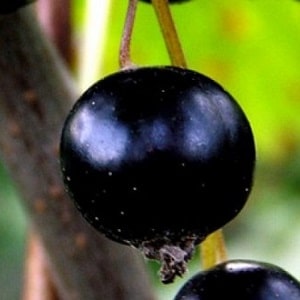 The flowers are large, goblet-shaped, wide at the base, sepals are medium-sized, lanceolate, purple in color, bent in an arc. The brushes are 5-7 cm long, cylindrical in shape, arranged singly with an arcuate bend.
The flowers are large, goblet-shaped, wide at the base, sepals are medium-sized, lanceolate, purple in color, bent in an arc. The brushes are 5-7 cm long, cylindrical in shape, arranged singly with an arcuate bend.
The berries are round, weigh 1.2-1.4 g, are black in color, and have a glossy skin. The pulp is juicy, sweet and sour, with an average amount of seeds. Tasting taste score: 4.8 points. The calyx is closed, medium in size, round in shape, the stalk is medium, straight. Chemical composition of the berry: 13% dry matter, 9.7% sugars, 2.7% acid, 129.4 mg/100 g vitamin C, 1.6% pectin.
Resistance to environmental conditions
The Charovnitsa variety is characterized by winter hardiness: the root system can withstand temperatures down to –15°C, open flowers – up to –3°C, ovaries – up to –2°C.
The drought resistance of the variety is above average. In the south of Russia, the shrub produces high yields.
Productivity
Charovnitsa is one of the high-yielding varieties of black currant. The average yield per bush is 3.1 kg.
The berries are fully ripened in mid-July. Maturation occurs gradually, so harvesting carried out in stages and completely completed in August.
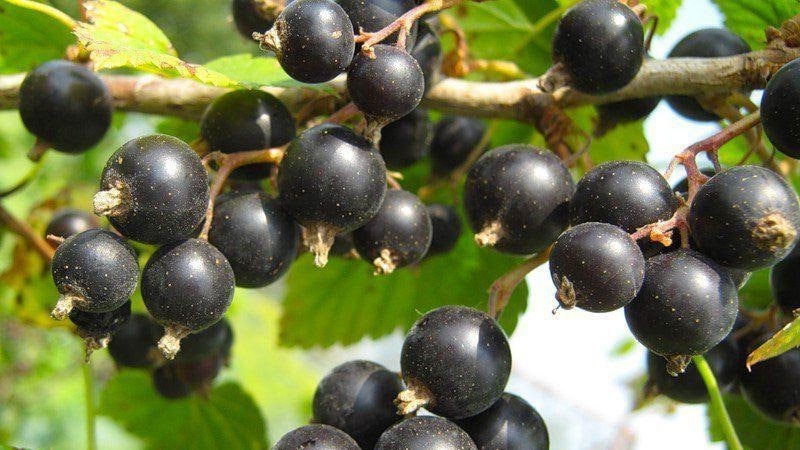
The variety as a whole is not prone to shedding, but the berries may fall off under the influence of unfavorable weather conditions:
- winter with little snow and severe frosts, which leads to freezing of the buds;
- severe spring frosts;
- cold, windy weather during the flowering period, which disrupts pollination and reduces the likelihood of fruit set.
The transportability of the variety is low. It is preferable to transport the crop at night or in refrigerated rooms.
Reference. The berries of the Charovnitsa variety are often not baked in the sun. If this happens, it is only due to the fault of the glass caterpillar.
The variety is not characterized by crushing of the berries, but this can be observed in a number of cases:
- proper care of shrubs;
- landing in an inappropriate place;
- shading by dense tree crowns;
- neglect of pruning old and diseased branches.
Application area
The berries of the Charovnitsa variety are consumed fresh, frozen, ground with sugar and stored in the refrigerator, jam, marshmallows, marmalade, marshmallows, jelly, and sauces for meat are prepared.
Pros and cons of the variety
Advantages of the variety:
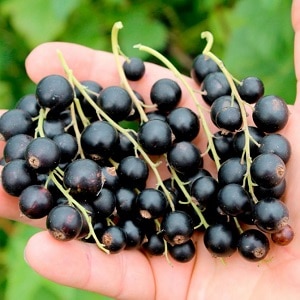 consistently high productivity;
consistently high productivity;- early ripening;
- immunity to powdery mildew;
- excellent taste;
- universal purpose;
- winter and drought resistance.
Disadvantage: predisposition to kidney mites.
Growing technology
Planting of seedlings is carried out in spring or autumn, observing a number of general rules for the Central Black Earth region and central Russia:
- For planting, choose a well-lit place, protected from drafts, on a hill or with low groundwater.
- The soil temperature during planting should not be lower than +5°C.
- Optimal planting dates are April – May, September – October. In the regions of central Russia, it is important to do it before the end of September so that the plant has time to take root before frost.
- Annual seedlings 40-50 cm high, without leaves, are planted. Dry and weathered roots are reanimated with Kornevin solution. To do this, seedlings are immersed in liquid for 2-3 days.
- Before boarding branches are pruned by 1/2 or 2/3 of the length.
- To improve the quality of the harvest, several different varieties of blackcurrants are planted nearby.
- A distance of 1.5 m is maintained between plantings.
- The earth is loosened and weeds are removed.
- The depth of the planting hole is 40 cm, width is 60 cm.
- When planting, the soil is fed with organic matter: 4-5 kg of humus and 150 g of wood ash are placed at the bottom.
- To retain moisture, the roots are dipped in a clay mash immediately before planting.
- A low mound is formed at the bottom of the pit, and a seedling is placed on top.
- The hole is filled with fertile soil, deepening the root collar by 10 cm.
- A depression with a diameter of 40 cm is formed around the bush and watered with water. Consumption - 10-15 l per 1 bush.
- The tree trunk circle is covered with mulch - compost or peat.
Care
The health of the crop and the quality of the harvest directly depend on further care. The main tasks of a gardener are:
- Timely sanitary and formative pruning.
- The bush should consist of 15 shoots - 3 pieces each. from every year.
- Water the bushes need 2-3 times a week. Consumption for an adult bush is 10 liters of settled water. During drought, it is recommended to water currants in the morning and evening. During the fruiting period, the crop is given abundant watering.
- In winter, the tree trunk circle is insulated with horse manure, protecting the root system in winters with little snow. Currant branches are bent to the ground and fixed. The top is covered with spunbond or spruce branches for additional protection from rodents.
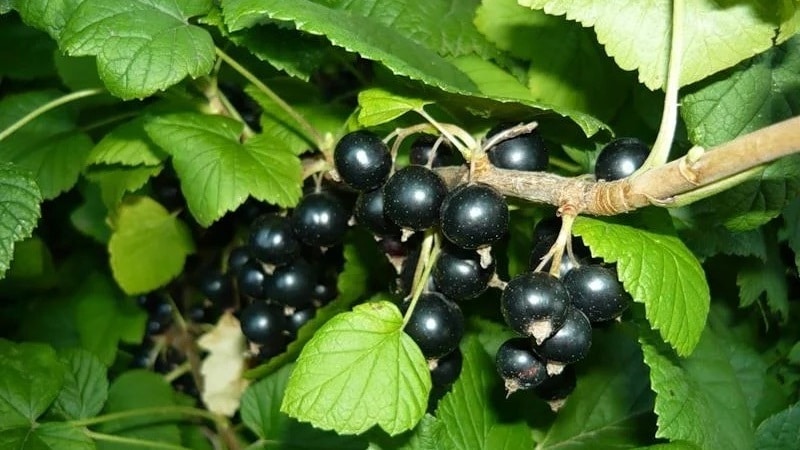
Fertilizing with organic matter is carried out in the spring before green mass is gained. Potassium and phosphorus are added to improve fruiting and taste of currants.
| View | Norm per 1 m² | Application time |
| Organic solids |
|
Every year in September - October for digging. |
| Organic liquid | 1 liter of chicken manure per 10 liters of water. | Every year in the spring before flowering at the root. |
| Nitrogen | 20 g ammonium nitrate per 1 m² | 3 years after planting, flowering and during the formation of ovaries. |
| Mineral | 20-30 g of potassium and 30-40 g of phosphorus. | In the fall, under digging. |
For fruit-bearing bushes, the fertilizer rate is doubled. Towards unconventional methods fertilizing currants include the following:
- 2-3 liters of bread kvass for watering at the root;
- potato peels are scattered around the tree trunk;
- Green manure is sown near the bushes, then mowed and embedded in the soil.
Possible problems, diseases, pests
The main pests of the Charovnitsa variety are currant bud mites, aphids, gall midges, bud moths, glass beetles, and moths. Insecticides are used to control pests. Folk remedies are effective only at the initial stage of infection.
The table shows methods of controlling insects.
| Pests | Signs | Drugs | Processing period |
| Kidney mite, gall midge, glass beetle | Growths, dry buds | 300 g of Nitrafen per 10 liters of water or 100 g of colloidal sulfur per 10 liters | Before the buds open |
| Aphids, bud moths | Dry leaves, colonies of black insects on the back of the leaf | 30 g of Karbofos per 10 liters of water | Before the buds open |
| Ognevka | Rotten berries, dry leaves | 20 g of Chlorophos per 10 liters of water | Before flowering |
Reproduction
Black currant variety Charovnitsa is propagated in several ways:
- Seeds. The method is often used by breeders to develop new varieties.
- Cuttings. Young and woody ones are cut in June. The length of the cutting is 10-15 cm. The bottom is cut at an angle, the top is left straight.
- By layering. The lower shoots are tilted to the ground and sprinkled with soil. The tops are left on the surface. In autumn, the cuttings are separated from the bush and planted in a permanent place.
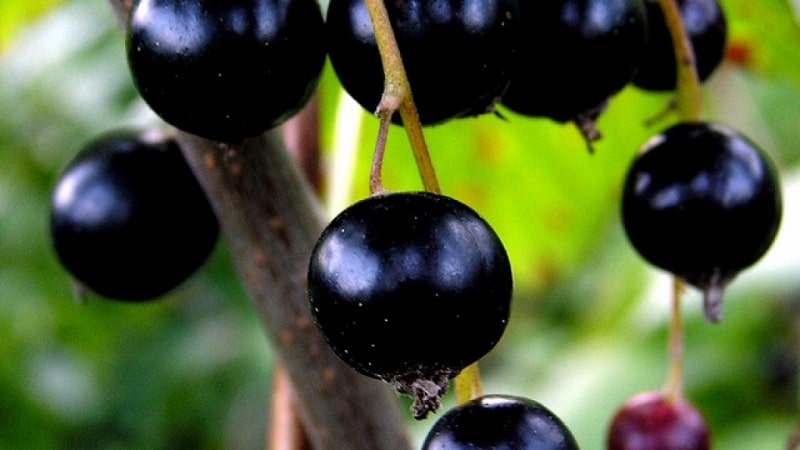
Reviews from summer residents
Gardeners speak positively about the Charovnitsa variety and value it for its high yield and excellent taste of berries.
Ivan, Voronezh: “The Charovnitsa variety is the main one on my currant plantation. I appreciate it for its ease of care, resistance to frost and drought, and immunity to powdery mildew. In the 5 years that I have been growing it at my dacha, I have never had the opportunity to treat it for powdery mildew.Sometimes I have to devote all my strength to destroying the kidney mite, but colloidal sulfur and Karbofos help me with this. I recommend Enchantress for planting to everyone who loves sour berries and cannot constantly travel to the plot.".
Vera, Tambov: “Currant Enchantress has been pleasing us with high yields of sweet and sour juicy berries for several years in a row. You don't need to fuss too much with bushes. It’s enough to prune in the spring, control watering, feed with organic matter in the spring and minerals in the summer.”.
Yaroslav, Belgorod: “I have been successfully growing the high-yielding blackcurrant variety Charovnitsa for almost 10 years. Over the years, he has never let me down. For my part, I try to monitor the health of the plant, I water it on time, fertilize it and treat it against insects. From one bush I annually collect about 3 g of selected berries. We prepare compotes and jam from them for the winter, and freeze them for future use. This variety of currant makes a very tasty jam, which is perfectly stored in the refrigerator and becomes jelly-like.”.
Conclusion
The black currant variety Charovnitsa literally charmed the summer residents of the Central Black Earth region, because it is in this territory that it has been successfully grown since 2006. The crop is resistant to drought and frost, is not susceptible to powdery mildew, and bears fruit abundantly, provided that it is maintained in good health and follows basic care procedures. The bushes need annual pruning, fertilizing with organic and mineral fertilizers, treatment against insects, and shelter in winters with little snow. The berries have a pleasant sweet and sour taste, for which they were highly appreciated by tasters and summer residents.